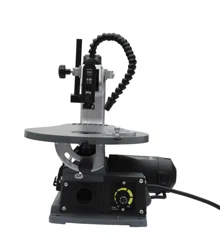Loading ...
Loading ...
Loading ...

WARNING: Before removing loose pieces from the table or making adjustments, turn saw off and wait for all
moving parts to stop to avoid serious personal injury.
BASIC OPERATION OF THE SCROLL SAW
Before starting a cut, watch the saw run. If you experience excessive vibration or unusual noise, stop immediately. Turn
the saw off, remove the switch key, and unplug the saw. Do not restart until locating and correcting the problem.
CUTTING PROCEDURES
• There is a learning curve for each person who wants to use this saw. During that period of time it is expected that some
blades will break until you learn how to use and adjust the saw.
• Plan the way you will hold the workpiece from start to nish.
• Keep your hands away from the blade. Do not hand hold pieces so small your ngers will go under the blade protect
board.
• Hold the workpiece rmly against the work table.
• The blade teeth cut material only on the down stroke.
• Use gentle pressure and both hands when feeding the work into the blade. Do not force the work.
• Guide the workpiece into the blade slowly because the teeth of the blade are very small and can only remove material
on the down stroke.
• Avoid awkward operations and hand positions where a sudden slip could cause serious injury from contact with the blade.
Never place hands in blade path.
• To get accurate cuts, compensate for the blade's tendency to follow the wood grain as you are cutting wood.
• Use extra supports (tables, saw horses, blocks, etc.) when cutting large, small or awkward workpieces.
• Never use another person as a substitute for a table extension or as additional support for a workpiece that is longer or
wider than the basic saw table.
• When cutting irregularly shaped workpieces, plan your work so it will not pinch the blade. Workpieces must not twist,
rock or slip while being cut.
REMOVING JAMMED MATERIAL
When backing out the workpiece, the blade may bind in the kerf (cut). This is usually caused by sawdust clogging the kerf
or when the blade comes out of the blade holders. If this happens:
AVOIDING INJURY
• Make sure saw is level and does not rock. Saw should always be on a rm, level surface with plenty of room for handling
and properly supporting the workpiece.
• Bolt saw to the support surface to prevent slipping, walking or sliding during operations like cutting long, heavy boards.
• Turn saw off and unplug cord from the power source before moving the saw.
• Do not remove jammed pieces until blade has come to a full and complete stop.
• Choose the right size and style blade for the material and type of cut you plan to do.
• Use only recommended accessories.
• Wait until the saw has come to a full and complete stop.
• Place the switch in the off position.
• Unplug the saw from the power source.
• Remove the saw's blade and the workpiece, refer to section on “blade removal and installation.”
• Wedge the kerf open with a at screwdriver or wooden wedge, then remove the blade from the workpiece.
Page 19
OPERATION
CAUTION: After the saw is turned on, a hesitation before blade movement is normal.
Loading ...
Loading ...
Loading ...
